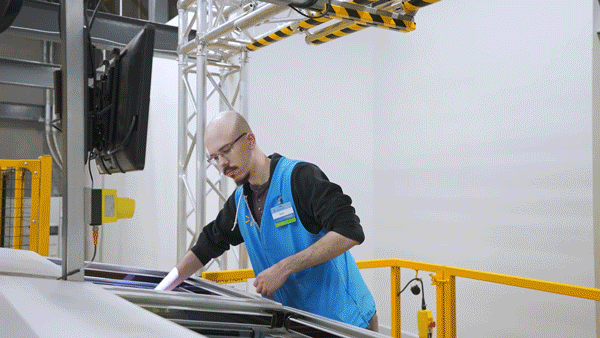How Walmart Slashed Fulfillment Costs by 15% and Achieved 80% Same-Day Delivery
Over the past year, Walmart U.S. has increased the percentage of digital orders fulfilled by stores by 8 percentage points, and Sam’s Club fulfills nearly 60 percent of online orders from its clubs.
WALMART U.S. HAS INCREASED THE PERCENTAGE OF DIGITAL ORDERS FULFILLED BY STORES BY 8 PERCENTAGE POINTS OVER THE PAST YEAR, ACCORDING TO CHIEF FINANCIAL OFFICER JOHN DAVID RAINEY. COURTESY OF WALMART
How Walmart Cut ‘Store-to-Home’ Delivery Costs By 15%
Walmart’s steady third quarter saw the retail giant increase year-over-year sales 5.2 percent to $160.8 billion on net income of $643 million. However, executives said they’re thinking “slightly more cautiously about the consumer” versus three months ago.
America’s largest retailer expects to shore up its margins in the next several years with its robust investments in fulfillment. It already operates nine regional distribution centers servicing U.S. stores with varying levels of automation.
In Wednesday’s third quarter earnings call, Walmart chief financial officer John David Rainey said the retailer is building six new centers.
“Currently, more than 15 percent of stores receive merchandise from these facilities, helping to get product to shelves faster and more efficiently,” Rainey said during the call.
Rainey said Walmart opened its third next-generation e-commerce fulfillment center in Lancaster, Texas in October. The 1.5-million-square-foot facility should more than double the storage capacity and double the number of customer orders fulfilled daily.
These next-gen facilities, another of which will be built in Stockton, Calif. in 2026, will expand next- and two-day shipping to nearly 90 percent of the U.S., including marketplace items shipped by Walmart Fulfillment Services (WFS).
According to Rainey, the next-gen fulfillment centers will help some Walmart’s associates transition into higher-skilled, tech-focused positions.
To support the store-fulfilled digital business, Walmart is on track to have seven stores with automated market fulfillment centers (MFCs) operational by the end of November.
Powered by a proprietary storage and retrieval system called Alphabot, which Walmart acquired last October when it bought robotics company Alert Innovation, MFCs include autonomous bots that store, retrieve and dispense orders by moving horizontally, laterally and vertically without any lifts or conveyors. The retailer is using the technology to promise faster fulfillment with lower substitutions.
“These MFCs stock thousands of the most sought-after items and are expected to increase order capacity and productivity while also increasing inventory accuracy, which helps us deliver perfect orders for customers,” said Rainey.
As Walmart works to improve its e-commerce margins, Rainey said the Bentonville behemoth is making “good progress” in lowering digital fulfillment costs and densifying the last mile via its store network.
Powered by a proprietary storage and retrieval system called Alphabot, which Walmart acquired last October when it bought robotics company Alert Innovation, MFCs include autonomous bots that store, retrieve and dispense orders by moving horizontally, laterally and vertically without any lifts or conveyors. The retailer is using the technology to promise faster fulfillment with lower substitutions.
“Over the past year, Walmart U.S. has increased the percentage of digital orders fulfilled by stores by 800 basis points (8 percentage points), and Sam’s Club fulfills nearly 60 percent of online orders from its clubs,” said Rainey. “With the growth of our Spark Driver platform, we’ve lowered store-to-home delivery costs by 15 percent, even as we’ve shortened delivery times to same-day for more than 80 percent of our stores and, in some cases, as quick as 30 minutes.”
Walmart’s GoLocal B2B delivery program, which recently hired Shipt’s Rina Hurst as its new vice president, is approaching 12 million last-mile deliveries for other retailers using the service, which include The Home Depot and Chico’s FAS.
The company expects to increase revenue by ramping up its Marketplace offering. Over the past year, Rainey said the company grew marketplace sellers by more than 20 percent, and the number of sellers utilizing WFS is up over 55 percent. WFS has expanded internationally to Mexico, Canada and South Africa.
CEO Doug McMillon is confident in Walmart’s fourth-quarter and full-year financial goals.
“We expect to have a healthy top line,” McMillon said. “And as it relates to operating income, we’ve got a really good multi-year plan with two primary dimensions. One is the automation investments that will drive productivity improvements, and the other dimension is related to how the digital businesses change the shape of the income statement. Both of those things will be true, and it’s a multi-year plan that shows progress along the way.”
Walmart wasn’t the only mass merchant touting its supply chain improvements for e-commerce.
According to John Mulligan, Target’s executive vice president and chief operating officer, the percentage of digital orders picked and shipped on time and the average Drive-Up wait time have all improved from last year. Also, the percent of items ordered but not found has declined from a year ago, “meaning that we are fulfilling more items per order and canceling fewer,” Mulligan said.
Target said same-day services saw high-single-digit comp growth led by Drive-Up, which expanded 12 percent.
BY GLENN TAYLOR on NOVEMBER 17, 2023
High-Performance Automaton Storage System
Ultra High-Density Storage.
75%+ reduction is floor space
No aisles needed.
Fast access to the bins thanks to low stacks.


